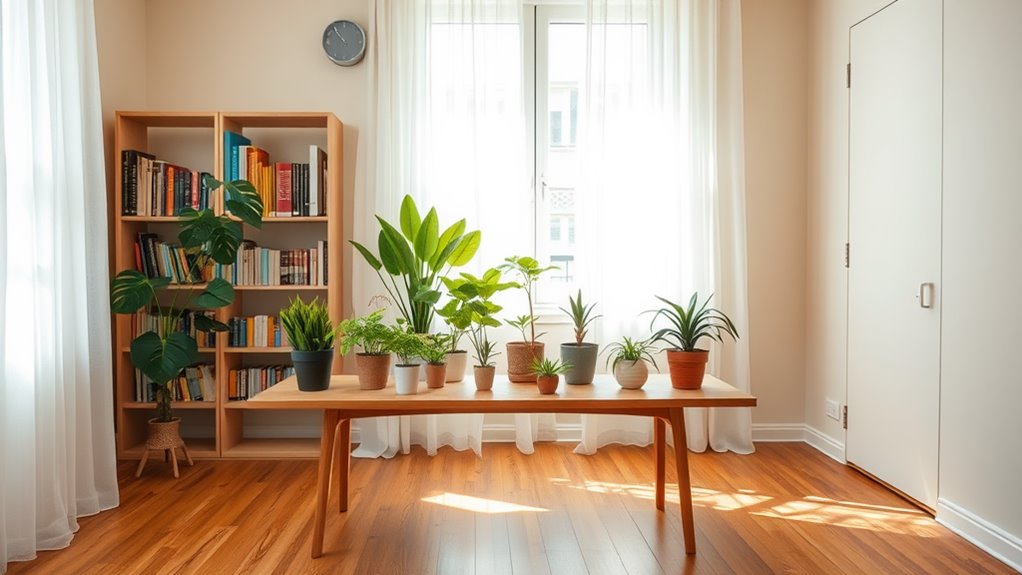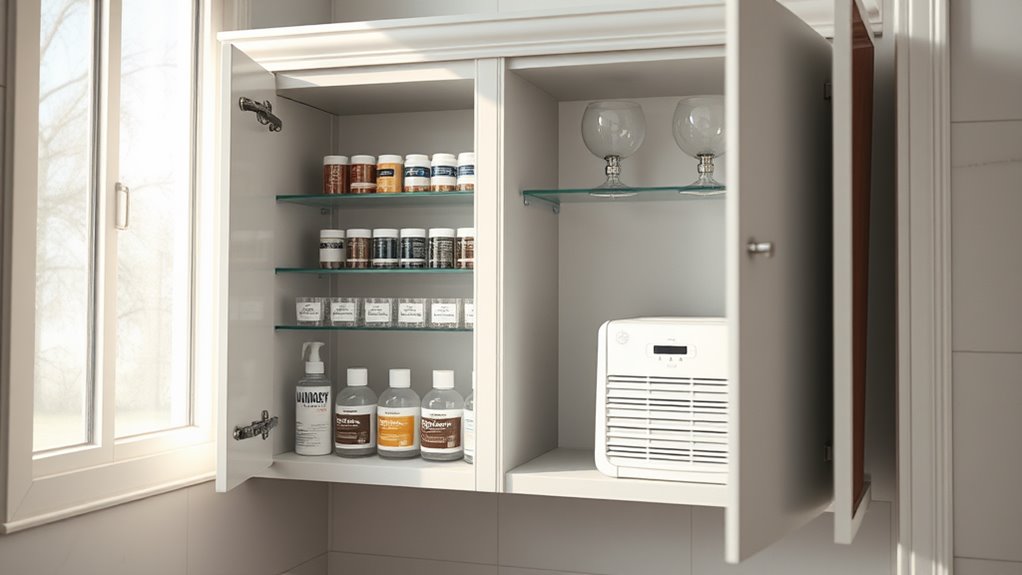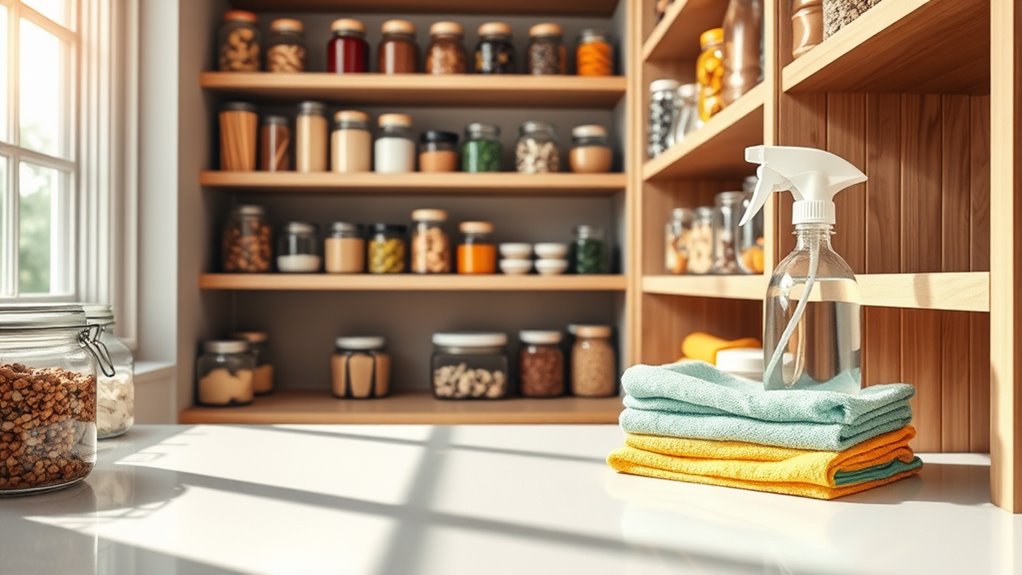The Decluttering Method That Finally Worked for Me
The decluttering method that finally works for you might be the “One-In-One-Out” rule. This strategy pairs each new item with the removal of an existing one, making it easier to manage your belongings. It helps you regain control and encourages mindful consumption. Combine this with daily 15-minute sessions for lasting impact, and you’ll find it’s not just your space that transforms, but your mindset, too. There’s more to explore that can enhance your decluttering journey.
Key Takeaways
- I embraced the KonMari Method, focusing only on items that sparked joy, which simplified my decision-making process.
- Implementing the 20/20 rule helped me let go of easily replaceable items without guilt, freeing up space quickly.
- I committed to daily 15-minute decluttering sessions, which made the process manageable and consistent over time.
- The Maybe Box Technique allowed me to delay decisions on uncertain items, reducing stress and maintaining momentum.
- Establishing a one-in-one-out rule for new items helped me maintain a clutter-free environment and encouraged mindful consumption.
My Struggles With Clutter
Whenever you walk into a room stuffed with items you don’t use, it’s easy to feel overwhelmed by clutter. You might find yourself paralyzed, unsure where to start. Each item seems to hold a memory or a potential future use, making it tough to let go.
I remember trying various methods, but nothing clicked until I discovered a simple decluttering hack: the 20/20 rule. If you can replace an item for under $20 and within 20 minutes, it’s time to let it go. This strategy shifted my mindset, allowing me to focus on what truly matters. Embrace the liberation that comes from shedding excess; you’ll find clarity and space to breathe, paving the way for a more intentional life. Implementing the “one in, one out” rule was another critical step in my journey toward minimalism. Additionally, reflecting on key questions during the process can provide deeper insights into your emotional attachments and help guide your decisions. Incorporating daily cleaning habits into your routine can also mitigate the buildup of clutter over time. Participating in a 10-minute declutter challenge can also offer a quick and effective way to tackle your space without feeling overwhelmed. Ultimately, the combination of these techniques led me to discover my successful three-step approach that finally transformed my home into a clutter-free sanctuary.
Exploring Popular Decluttering Techniques
As you plunge into the world of decluttering, you’ll find a variety of popular techniques that can simplify the process and help you regain control over your space.
One effective approach is the KonMari Method, which encourages you to keep only those items that spark joy.
Another method is the Four-Box Technique, where you sort items into categories: keep, donate, trash, and relocate.
The Minimalist Game challenges you to eliminate a specific number of items each day for a month, fostering momentum.
Alternatively, the 20/20 Rule suggests that if you can replace an item for under $20 and within 20 minutes, it’s easier to let it go.
Experiment with these techniques to discover what resonates with you and supports your decluttering journey.
The “One-In-One-Out” Rule
Among the various decluttering techniques, the “One-In-One-Out” rule stands out for its simplicity and effectiveness. By adopting this practice, you commit to removing one item from your space for every new item you bring in. This approach aligns with the one-touch rule, which emphasizes making immediate decisions about items and can significantly streamline your decluttering process. Additionally, implementing a quick decluttering technique can help you tackle larger areas of your space more efficiently. To further reinforce your commitment to a clutter-free environment, consider incorporating a cleaning schedule that suits your lifestyle and helps maintain your space. The 5-bin sorting system can also be an excellent method to categorize items as you declutter.
This rule not only prevents accumulation but also encourages mindful consumption. Each time you consider a purchase, ask yourself what you can part with. This mindset fosters intentionality, ensuring that every item you own adds value to your life. Implementing a daily 5-minute reset routine can further enhance your efforts by maintaining designated spots for essential items.
As you consistently apply the “One-In-One-Out” rule, you’ll notice your environment becoming more organized and less overwhelming. Over time, this practice cultivates a habit of appreciating what you have while keeping clutter at bay, ultimately leading to a more harmonious living space.
The Power of 15-Minute Daily Sessions
When it comes to decluttering, consistency beats perfection every time.
By dedicating just 15 minutes a day, you can tackle focused tasks and create quick wins that keep you motivated. This approach allows you to engage in small, manageable actions that lead to significant results over time. You’ll be amazed at how much progress you can make in such a short time! Incorporating a 15-minute evening cleaning routine into your daily schedule can further enhance your decluttering efforts and promote a calm environment. Additionally, utilizing smart shortcuts can help streamline your cleaning process and save even more time. Establishing a strategic daily cleaning routine can also help maintain the organization and prevent clutter from accumulating again. Using innovative strategies such as setting a timer can help you stay focused and make the most of your 15-minute sessions.
Consistency Over Perfection
Consistency breeds progress, and committing to just 15 minutes a day can transform your decluttering journey. Instead of aiming for perfection, focus on these short sessions that build momentum. Each day, you can tackle a specific area, whether it’s a drawer or a shelf, allowing you to make tangible progress without feeling overwhelmed.
These daily sessions create a habit, reinforcing your commitment to decluttering. As you consistently engage in this practice, you’ll notice improvements in both your space and mindset.
Focused Task Management
Building on those daily 15-minute sessions can lead to effective focused task management. By dedicating a short, uninterrupted block of time, you create an environment where productivity thrives.
During these sessions, zero in on a single task that demands your attention. This focused approach not only sharpens your concentration but also enhances the quality of your work.
As you consistently engage in these 15-minute bursts, you’ll notice a reduction in overwhelm and an increase in your sense of accomplishment. Prioritize your tasks, set clear goals for each session, and watch how this method transforms your productivity.
Embrace this disciplined strategy, and you’ll master your time, ensuring that every minute counts toward your ultimate objectives.
Quick Wins Motivation
Just 15 minutes a day can lead to powerful quick wins that boost your motivation.
This short, focused time frame makes decluttering manageable, preventing overwhelm. You can tackle one drawer, sort a stack of papers, or clear a section of your closet.
Each completed task reinforces your sense of accomplishment, propelling you toward your ultimate goal of a decluttered space.
Introducing the “Maybe Box” Technique
While decluttering can often feel overwhelming, the “Maybe Box” technique offers a simple yet effective solution.
Here’s how it works: designate a box for items you’re uncertain about. Instead of making immediate decisions, place those items inside the box. This approach allows you to pause, giving yourself time to reflect on their true value.
Set a timeline—say, a month or two. If you don’t retrieve an item during that period, it’s a clear sign you can let it go.
This method not only reduces decision fatigue but also helps you hone your instincts about what truly matters. Embrace the “Maybe Box” and transform your clutter into clarity, gaining confidence in your decluttering journey.
Combining the Three Steps for Success
To achieve lasting decluttering success, you need to combine three essential steps: assess your space, sort and categorize, and maintain consistency.
By evaluating what you have, organizing it effectively, and sticking to your plan, you’ll create a more manageable environment.
Let’s explore how these steps work together to simplify your space.
Assess Your Space
Evaluating your space is an essential first step in any decluttering journey, and it can make all the difference in achieving your goals. When you assess your environment, you gain valuable insights into what truly matters to you. Take a moment to reflect on how your space currently feels versus how you want it to feel. This clarity will drive your decluttering decisions.
| Current Feeling | Desired Feeling |
|---|---|
| Overwhelmed and Stressed | Calm and Inviting |
| Chaotic and Disorganized | Functional and Efficient |
| Stagnant and Uninspired | Energized and Motivated |
Sort and Categorize
As you immerse yourself in the decluttering process, sorting and categorizing your belongings can greatly streamline your efforts.
Start by creating distinct piles or boxes for different categories—like keep, donate, and discard. This visual separation helps you make decisions more effectively.
Within each category, consider further subcategories; for instance, group clothes by season or function. This clarity allows you to see exactly what you have and what you truly need.
Stay focused on your goals and don’t get sidetracked by nostalgia.
As you sort, ask yourself if each item adds value to your life. By methodically categorizing, you prepare yourself for a more organized space, making the final steps of decluttering much easier and more satisfying.
Maintain Consistency
While it’s important to sort and categorize your belongings, maintaining consistency is crucial for long-term success in decluttering. You need to integrate the three steps—sorting, categorizing, and regularly revisiting your space—into your daily routine. Commit to a timeframe for check-ins and hold yourself accountable.
| Emotion | Action | Result |
|---|---|---|
| Overwhelm | Set small goals | Steady progress |
| Frustration | Create a schedule | Improved focus |
| Satisfaction | Celebrate milestones | Lasting motivation |
Transforming My Space and Mindset
When you take the plunge to declutter your space, you’re not just clearing out physical items; you’re also reshaping your mindset. As you remove the clutter, you create room for clarity, focus, and peace. This transformation empowers you to approach challenges with a renewed perspective.
-
Freedom: Letting go gives you the lightness to pursue what truly matters.
-
Focus: A clear space fosters a clearer mind, allowing you to concentrate on your goals.
-
Empowerment: Mastering your environment instills confidence, making you feel in control of your life.
Embrace this journey. Each item you release is a step toward a more intentional existence, leading to a fulfilling space and a liberated mindset.
Tips for Maintaining a Clutter-Free Home
To keep your home clutter-free, it’s essential to establish consistent habits that support your newfound organization.
Start with a daily tidying routine; spend just 10 minutes each day putting things back in their designated places.
Adopt the “one in, one out” rule—whenever you bring something new into your home, let go of an item you no longer need.
Create designated zones for frequently used items, making them easily accessible.
Regularly assess your belongings; if you haven’t used something in the last year, consider parting with it.
Finally, involve your family in maintaining the space, fostering a collective commitment to a clutter-free environment.
With these practices, you’ll master the art of sustaining a serene and organized home.
Frequently Asked Questions
How Do I Deal With Sentimental Items While Decluttering?
Dealing with sentimental items can be tough, but you can prioritize by selecting a few cherished pieces to keep. Consider taking photos of others, allowing you to retain memories without the physical clutter.
What Should I Do With Items I’m Unsure About?
When you’re unsure about items, evaluate their purpose and emotional value. Consider if they serve you now. If not, take a photo or box them for a while—revisit your decision later with a clearer mind.
Can Decluttering Help With Mental Health?
Absolutely, decluttering can greatly enhance your mental health. By removing distractions and creating a more organized space, you’ll feel more in control, reduce stress, and foster a clearer mindset. Embrace the transformation it brings.
How Often Should I Declutter My Space?
You should declutter your space regularly, ideally every few months. Establish a routine that fits your lifestyle, so you can maintain a clear environment. Frequent decluttering prevents overwhelm and keeps your space organized and invigorating.
Are There Any Apps That Assist With Decluttering?
Yes, there are several apps that can help you declutter effectively. Try using Marie Kondo’s app for inspiration, or explore digital inventory apps like Sortly. They’ll keep you organized and motivated throughout your decluttering journey.



